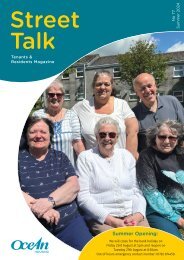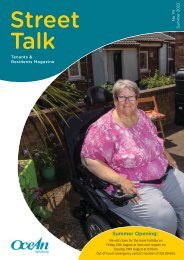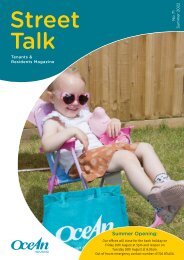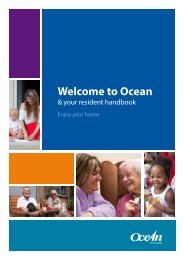Ocean Housing Health and Safety Booklet 2023
You also want an ePaper? Increase the reach of your titles
YUMPU automatically turns print PDFs into web optimized ePapers that Google loves.
Tenant Guide<br />
to Property <strong>Health</strong> & <strong>Safety</strong>
Our Tenant Guide to Property <strong>Health</strong> & <strong>Safety</strong><br />
contents<br />
Page:<br />
Asbestos Advice for Tenants<br />
2 - 4<br />
Condensation <strong>and</strong> Mould in the home<br />
5 - 8<br />
Gas <strong>Safety</strong> at home<br />
9 - 10<br />
Electrical <strong>Safety</strong> at home<br />
11 - 12<br />
Legionnaire’s Disease<br />
13 - 16<br />
Fire <strong>Safety</strong> in the home<br />
17 - 26
Asbestos Advice for Tenants<br />
INTRODUCTION<br />
A number of <strong>Ocean</strong> homes contain asbestos. <strong>Ocean</strong> is committed to ensure<br />
that all materials containing asbestos are safe. Asbestos containing materials<br />
(ACM’s) which are in good condition <strong>and</strong> not disturbed, do not pose a risk<br />
to your health.<br />
This information addresses concerns <strong>and</strong> questions about asbestos in<br />
homes. It explains what it is, where it is found, why it might be a problem<br />
<strong>and</strong> how to deal with it.<br />
Asbestos is resistant to heat <strong>and</strong> chemicals. This led to widespread use in a<br />
range of building products <strong>and</strong> materials from the 1930’s to the mid 1980’s.<br />
Uses included thermal <strong>and</strong> acoustic insulations, reinforcement in asbestos<br />
cement products <strong>and</strong> fire protection materials. Properties built after 1990<br />
are extremely unlikely to contain asbestos in the building.<br />
What is Asbestos?<br />
Asbestos is a naturally occurring mineral (fibrous silicate) that is<br />
contained within rock, these fibres are then separated <strong>and</strong> woven to<br />
make asbestos product:<br />
1. Amosite<br />
(known as Brown Asbestos)<br />
2. Chysotile<br />
(known as white Asbestos)<br />
3. Crocidolite<br />
(known as Blue Asbestos)<br />
2.
Where is asbestos likely to be in the home?<br />
It is not always easy to tell whether a product<br />
contains<br />
asbestos as modern asbestos-free materials<br />
often look similar – remember it is usually older<br />
products that contain asbestos. Loft or cavity<br />
wall insulation does not contain asbestos.<br />
Below identifies some common areas where<br />
asbestos may be found. The list is not<br />
all-inclusive as many products contain asbestos.<br />
Exterior<br />
1. Roof tiles/felt<br />
(house, shed or garage)<br />
2. Gutters <strong>and</strong> down-pipes<br />
3. Fascia/soffit boards<br />
Interior<br />
4. Partition walls<br />
5. Panels beneath windows<br />
6. Cupboards around<br />
domestic boilers<br />
7. Panels behind electrical<br />
equipment<br />
8. Bath Panels<br />
9. Panels inside fire doors<br />
10. Floor tiles<br />
11. Textured coatings (artex)<br />
12. Panels behind heaters<br />
or fires<br />
13. Gaskets <strong>and</strong> rope seals<br />
inside heating appliances<br />
14. Cold water storage tanks<br />
3.
What should I do if I suspect there is asbestos in my home?<br />
Make regular checks of any material you think contains asbestos.<br />
Do not touch it, but look for signs of wear <strong>and</strong> damage such as tears,<br />
abrasions or water damage. Damaged material may release asbestos<br />
fibres, especially if you often disturb it by working or h<strong>and</strong>ling it.<br />
Don’t<br />
Carry out DIY works, s<strong>and</strong>, drill or strip any products known to<br />
contain asbestos<br />
✓Do<br />
Try not to damage any product known to contain asbestos<br />
Do ✓<br />
Keep activities to a minimum where damaged products may<br />
contain asbestos<br />
✗ Don’t<br />
Asbestos Management<br />
<strong>Ocean</strong> has an Asbestos Policy <strong>and</strong> a comprehensive asset<br />
management register. These set out exactly how <strong>Ocean</strong> intends to<br />
identify <strong>and</strong> manage asbestos in all <strong>Ocean</strong> properties.<br />
As part of the ongoing stock condition survey<br />
process, <strong>Ocean</strong> will survey, identify <strong>and</strong> record any<br />
material suspected to contain asbestos.<br />
All asbestos containing material<br />
that is in good condition will remain<br />
in position <strong>and</strong> its condition will<br />
be regularly reviewed. If material<br />
is damaged, <strong>Ocean</strong> will take the<br />
necessary action to seal or have the<br />
asbestos removed.<br />
4.<br />
✗<br />
Dust, vacuum or sweep debris that may contain asbestos<br />
DO NOT TAKE RISKS –<br />
If in any doubt please contact <strong>Ocean</strong>
Condensation <strong>and</strong> Mould<br />
in your home<br />
What is condensation <strong>and</strong> what causes it?<br />
When you have had a hot bath or shower <strong>and</strong> the cold surface of the<br />
bathroom mirror mists over, this is condensation. It happens when warm<br />
moist air comes into contact with a cold surface or cold air <strong>and</strong> produces<br />
tiny droplets of water.<br />
Condensation can be more of a problem in the cold winter months,<br />
where it is often found next to windows, in the corners of rooms <strong>and</strong><br />
behind wardrobes. Over time this can cause black mould <strong>and</strong> damp<br />
patches to appear.<br />
What we do in our homes has a direct effect on the amount of<br />
condensation created. Cooking, washing, drying clothes inside, even<br />
breathing puts moisture into the air – but we don’t suggest you stop doing<br />
that!<br />
The good news is that there are easy steps you can take to prevent<br />
condensation <strong>and</strong> to stop the damp <strong>and</strong> mould it causes:<br />
5.
Reduce the moisture in your home<br />
• Avoid creating a lot of steam in the kitchen –<br />
cover pans <strong>and</strong> don’t leave the kettle boiling<br />
• If fitted, use an extractor fan when cooking<br />
or bathing <strong>and</strong> for at least 30 minutes<br />
afterwards<br />
• Shut the bathroom door when bathing or<br />
showering<br />
• If you are running a bath, put the cold<br />
water in first to reduce the amount of steam<br />
• Dry clothes outside <strong>and</strong> where this is not<br />
possible, in the bathroom with the door<br />
closed <strong>and</strong> windows open or extractor<br />
fan on<br />
• Do not dry washing on your radiators<br />
• Ensure the air from your tumble dryer is<br />
vented to the outside<br />
Ventilate your home to keep the air<br />
circulating<br />
• Keep a window or trickle vents slightly<br />
open when you’re using a room.<br />
• Move furniture away from walls to allow air<br />
to circulate behind<br />
• Air cupboards <strong>and</strong> wardrobes <strong>and</strong> avoid<br />
putting too much in them as this stops<br />
air circulating<br />
Keep your home at a constant temperature<br />
• In cold weather consider keeping the heating<br />
on at a constant temperature all day. Warm<br />
walls <strong>and</strong> an even temperature reduce the<br />
likelihood of condensation <strong>and</strong> damp<br />
6.
You can use this table below to work out how much moisture is<br />
produced in your home in a day:<br />
Some of the things<br />
that create moisture<br />
in the home<br />
Pints of Water produced<br />
2 people at home for 1 day<br />
Cooking <strong>and</strong> boiling a kettle<br />
Having a bath or shower<br />
Washing clothes<br />
Drying clothes<br />
Getting rid of mould <strong>and</strong> damp<br />
Any condensation that forms on surfaces should be wiped off promptly<br />
to prevent the risk of damp <strong>and</strong> mould. If mould still appears in your<br />
home, wipe it with a fungicidal wash – you can buy this in most large<br />
supermarkets or DIY stores. Alternatively you can use a very weak bleach<br />
solution.<br />
Please make sure you wear rubber gloves <strong>and</strong> follow manufacturer’s<br />
instructions<br />
Other causes of damp<br />
The only lasting way to avoid severe mould is to reduce condensation<br />
in your home by following the tips provided. In rare cases damp can be<br />
caused by other factors such as a leaking pipe, missing or broken roof<br />
tiles or blocked cavities. In these cases the damp normally leaves a ‘tide<br />
mark’ that can occur at any time of year. If you believe that damp is in<br />
your home is caused by such a defect, please call 01726 874450<br />
7.
If using a bleach<br />
solution for cleaning<br />
please make sure<br />
you wear rubber<br />
gloves <strong>and</strong> follow<br />
manufacturer’s<br />
instructions<br />
8.
Gas <strong>Safety</strong> at home<br />
It is important to take care of your gas appliances.<br />
Get your gas appliances checked once a year by our<br />
Gas Safe Registered Engineers. Annual maintenance not<br />
only helps keep your heating <strong>and</strong> hot water working<br />
properly, it helps keep you safe.<br />
Badly fitted <strong>and</strong> poorly serviced gas appliances can cause gas leaks, fires,<br />
explosions <strong>and</strong> carbon monoxide poisoning. Carbon monoxide is a highly<br />
poisonous gas. You cannot see it, taste it or smell it but it can kill quickly<br />
with no warning.<br />
If a gas fitter is not registered, they are working illegally <strong>and</strong> possibly<br />
unsafely. Saving pennies may seem may seem like a good idea but using an<br />
illegal gas fitter could cost you <strong>and</strong> your family your lives so don’t risk it.<br />
As a l<strong>and</strong>lord <strong>Ocean</strong> has a legal duty under gas safety law to have gas<br />
appliances checked once a year by their Gas Safe registered engineers <strong>and</strong><br />
will maintain them in accordance with manufacturer’s instructions. <strong>Ocean</strong><br />
will also issue a gas safety record following inspections <strong>and</strong> servicing.<br />
For more information on l<strong>and</strong>lords <strong>and</strong> tenants responsibilities visit:<br />
www.GasSafeRegister.co.uk/renting<br />
9.
Keep safe in your home with these top tips:<br />
• Only use a Gas Safe registered engineer to fit, fix or service your<br />
gas appliances<br />
• Get your gas appliances regularly serviced according to the<br />
manufacturer’s instructions <strong>and</strong> safety checked every year<br />
• The poisonous gas carbon monoxide cannot be seen or smelt.<br />
Fit an audible carbon monoxide alarm. It should be marked to<br />
EN 50291 <strong>and</strong> also have the British St<strong>and</strong>ards Kitemark or European<br />
approval organisations mark on it<br />
• Check for warning signs that your gas appliances are not working<br />
correctly, e.g. lazy yellow flames, black marks or stains around the<br />
appliance <strong>and</strong> too much condensation in the room<br />
• Remember the six main signs <strong>and</strong> symptoms of carbon<br />
monoxide poisoning:<br />
1. Headaches 4. Breathlessness<br />
2. Dizziness 5. Collapse<br />
3. Nausea 6. Loss of consciousness<br />
If you smell gas or think there<br />
might be a gas leak or a leak of<br />
fumes: turn off the gas at the<br />
meter, put out naked flames,<br />
open windows <strong>and</strong> immediately<br />
call the gas emergency number.<br />
Seek medical advice if you<br />
feel unwell.<br />
Gas Emergency contacts:<br />
0800 111 999<br />
10.
Electrical <strong>Safety</strong> at home<br />
Much like an MOT for cars it is important that you ensure you carry out<br />
checks on the condition of the electrics in your home at regular intervals.<br />
This will help identify any faults or defects which could require<br />
improvement <strong>and</strong> will ensure the continued operation of the installation in<br />
a safe <strong>and</strong> effective manner.<br />
Visual Inspections<br />
A visual inspection is a basic check that can identify any visible signs of<br />
defects or damage to electrical systems or appliances. Below is a list of<br />
things that can easily be visually checked:<br />
• Consumer unit (main fuse board)<br />
• Sockets<br />
• Plugs<br />
• Light fittings<br />
• Electrical cables <strong>and</strong> leads<br />
• Signs of wear <strong>and</strong> tear<br />
• Visible signs of burning/scorching<br />
11.
Electrical Installation Condition Report (EICR)<br />
An electrical installation condition report (EICR) is an inspection that will<br />
be conducted by <strong>Ocean</strong>’s qualified electricians within a 5 year period<br />
<strong>and</strong> identifies any damage, deterioration, defects <strong>and</strong>/or conditions<br />
which may give rise to danger along with observations for which<br />
improvements may be made.<br />
As a l<strong>and</strong>lord <strong>Ocean</strong> has the responsibility to ensure that the electrical<br />
installation in a rented property is safe when tenants move in <strong>and</strong><br />
maintained throughout its duration. If you have any issues with the<br />
electrical installation in your property you can contact <strong>Ocean</strong> on<br />
01726 874450.<br />
12.
Legionnaire’s Disease<br />
This information is provided to inform you about the risks of contracting<br />
legionnaire’s disease, <strong>and</strong> how to safely prevent it. As your L<strong>and</strong>lord, we<br />
want to ensure that you are aware of possible causes <strong>and</strong> symptoms of<br />
Legionnaire’s disease so you can identify problems easily <strong>and</strong> contact us<br />
here at <strong>Ocean</strong> if you have concerns.<br />
What is Legionnaire’s Disease?<br />
Legionnaire’s disease is a potentially fatal form of pneumonia, which can<br />
affect anybody. It is caused by inhalation of small droplets of water from<br />
contaminated sources containing the legionella bacteria.<br />
13.
Where is Legionella found?<br />
All hot <strong>and</strong> cold water systems in residential properties are a potential<br />
source for legionella bacteria growth.<br />
The main areas of risk are where the bacteria can multiply <strong>and</strong> increase to<br />
dangerous levels <strong>and</strong> then spread, eg: in spray from showers <strong>and</strong> taps, even<br />
in dishwasher <strong>and</strong> washing machine pipes.<br />
Conditions ripe for colonisation are where water of between 20°C <strong>and</strong> 45°C<br />
stagnates, <strong>and</strong> where there is sludge, rust <strong>and</strong> scale present for the bacteria<br />
to feed upon <strong>and</strong> multiply.<br />
Who is at Risk?<br />
Legionnaire’s disease most commonly affects the elderly, or people with<br />
chest or lung problems. Not everyone exposed to legionella bacteria<br />
becomes ill. Legionnaire’s disease is not contagious <strong>and</strong> you cannot get it<br />
from drinking water.<br />
On average there are approximately 500 reported cases of legionnaire’s<br />
disease a year. The symptoms of Legionnaire’s disease are similar to<br />
those of flu:<br />
• High temperature<br />
• Fever or chills<br />
• Headache<br />
• Tiredness<br />
• Muscle pain<br />
• Dry cough<br />
14.
There is no need for concern. Legionnaire’s disease is easily preventable<br />
by putting in place some simple control measures. The information<br />
below will help you identify any potential problems.<br />
Taking the following simple precautions will help keep you safe:<br />
1. Flush through showers <strong>and</strong> taps for 10 minutes following<br />
a period of non-use (ie: after you have been on holiday<br />
or if a room is not in regular use)<br />
2. Keep all shower heads <strong>and</strong> taps clean <strong>and</strong> free from<br />
a build-up of limescale, mould or algae growth<br />
(regular bleaching every 3 months will help sterillise<br />
<strong>and</strong> kill any bacteria)<br />
3. Keep hot water on your boiler system at a temperature of 60°C<br />
or greater.<br />
Warning: BE AWARE OF SCALDING!<br />
4. Flush toilets with the lid down following a period of non-use<br />
5. Drain hosepipes after use <strong>and</strong> keep out of direct sunlight. Flush<br />
through for a couple of minutes before filling paddling pools etc<br />
6. Keep Spa’s <strong>and</strong> Hot Tub’s clean <strong>and</strong> free from dirt <strong>and</strong> debris <strong>and</strong><br />
check <strong>and</strong> clean the filters.<br />
15.
What do I do if I think I may have contracted Legionnaire’s<br />
disease?<br />
If you suspect that you or someone in your home has contracted<br />
Legionnaire’s disease, contact your doctor immediately. You should also<br />
contact <strong>Ocean</strong> so we can take the appropriate measures.<br />
You cannot get Legionnaire’s disease from drinking water.<br />
People catch legionnaire’s disease by inhaling small droplets<br />
of water suspended in air, which contain bacteria. The bacteria<br />
has to be in very small droplets like a spray from a shower or taps.<br />
In domestic properties the risk of Legionnaire’s disease is rated<br />
as low risk.<br />
16.
Fire <strong>Safety</strong> in the home<br />
In case of a fire, keep calm <strong>and</strong> act<br />
quickly, get everyone out as soon<br />
as possible<br />
GET OUT, STAY OUT<br />
AND CALL 999<br />
17.
Did you Know?<br />
• You are four times more likely to die in a fire if you don’t have a<br />
smoke alarm that works<br />
• Around half of all fires in the home are caused by cooking accidents<br />
• Two fires every day are started by c<strong>and</strong>les<br />
• Every six days someone dies in a fire caused by a cigarette<br />
• About two fires a day are caused by heaters<br />
• Faulty electrics (appliances, wiring <strong>and</strong> overloaded sockets) cause<br />
around 6000 fires in the home across the UK every year<br />
18.
MAKING YOUR HOME SAFE<br />
Smoke Alarms<br />
Smoke alarms save lives<br />
Test your smoke alarm at least monthly<br />
If your smoke alarm is not working, contact <strong>Ocean</strong> on 01726 874450<br />
immediately<br />
Never tamper with or remove your smoke alarms<br />
<strong>Ocean</strong> will test <strong>and</strong> check the smoke alarms in your property annually<br />
Make a fire action plan<br />
In case of a fire be prepared by making a plan of escape:<br />
• Plan <strong>and</strong> escape route <strong>and</strong> make sure everyone knows how to escape<br />
• Make sure exits are kept clear<br />
• The best route is the normal way in <strong>and</strong> out of your home<br />
• Think of a second route in case the first one is blocked<br />
• Take a few minutes to practice your escape plan<br />
• Review your plan if the layout of your home changes<br />
• Keep door <strong>and</strong> window keys where everyone can find them<br />
19.
What to do if there is a fire<br />
Don’t tackle fires yourself, leave it to the professionals:<br />
• Keep calm <strong>and</strong> act quickly, get everyone out as soon as possible<br />
• Don’t waste time investigating what’s happened or rescuing valuables<br />
• If there’s smoke, keep low where the air is clear<br />
• Before you open a door check if its warm. If it is, don’t open it – fire is<br />
on the other side<br />
• Call 999 as soon as you are clear of the building<br />
GET OUT, STAY OUT AND CALL 999<br />
What to do if your escape route<br />
is blocked<br />
If you can’t get out, get everyone<br />
into one room, ideally with a<br />
window <strong>and</strong> phone.<br />
• Put bedding around the<br />
bottom of the door to block<br />
out the smoke<br />
• Call 999 then open the window<br />
<strong>and</strong> shout ‘Help Fire’<br />
• If you’re on the ground or first<br />
floor you may be able to<br />
escape through a window<br />
• Use bedding to cushion your<br />
fall <strong>and</strong> lower yourself down<br />
carefully, don’t jump<br />
• If you can’t open the window<br />
break the glass in the bottom<br />
corner. Make jagged edges safe<br />
with a towel or blanket.<br />
20.
What to do if your clothes catch fire<br />
• Don’t run around, you will make the flames worse<br />
• Lie down <strong>and</strong> roll around. It makes it harder for the fire to spread<br />
• Smother the flames with a heavy material, like a coat or blanket<br />
• Remember Stop, Drop <strong>and</strong> Roll<br />
STOP DROP & ROLL<br />
How to escape from a High Level Building<br />
As with all buildings you should plan <strong>and</strong><br />
practice your escape route<br />
Avoid using lifts <strong>and</strong> balconies if there is a fire<br />
It is easy to get confused in smoke, so count<br />
how many doors you need to go through to<br />
reach the stairs<br />
Check there is nothing in the corridors or<br />
stairways that could catch fire – like boxes or<br />
rubbish<br />
Make sure the doors to stairways are not<br />
blocked<br />
Make sure everyone in the building knows<br />
where the fire alarm is<br />
Ensure your smoke alarm is working <strong>and</strong> report<br />
any defects<br />
USE THE STAIRS<br />
21.
Bedtime checks<br />
You are most at risk from fire when asleep,<br />
always check your home before you go to bed.<br />
Here are some very quick <strong>and</strong> easy checks you<br />
can complete before you go to bed:<br />
• Close inside doors at night to stop fire<br />
spreading<br />
• Turn off <strong>and</strong> unplug electrical appliances<br />
unless they are designed to be left on like<br />
your freezer<br />
• Check your cooker is turned off<br />
• Don’t leave the washing machine on<br />
• Turn heaters off <strong>and</strong> put fire guards<br />
• Put c<strong>and</strong>les <strong>and</strong> cigarettes out properly<br />
• Make sure exits are kept clear<br />
• Keep door <strong>and</strong> window keys where<br />
everyone can find them<br />
22.
HOW TO PREVENT COMMON FIRES<br />
In the kitchen<br />
Take extra care if you need to leave the kitchen whilst cooking, take<br />
pans off the heat or turn them down to avoid risk.<br />
• Avoid cooking when under the influence of alcohol<br />
• Avoid leaving children in the kitchen alone when cooking on<br />
the hob. Keep matches <strong>and</strong> sauce pan h<strong>and</strong>les out of their reach<br />
• Take care if you’re wearing loose clothing - they can easily<br />
catch fire<br />
• Keep tea towels <strong>and</strong> cloths away from the cooker <strong>and</strong> hob<br />
• Spark devices are safer than matches or lighters to light gas<br />
cookers, because they don’t have a naked flame<br />
• Double check the cooker is off when you’ve finished cooking<br />
23.
Take care with electrics<br />
• Keep electrics (leads <strong>and</strong> appliances) away from<br />
water<br />
• Check toasters are clean <strong>and</strong> placed away from<br />
curtains <strong>and</strong> kitchen rolls<br />
Don’t put • Keep the oven, hob <strong>and</strong> grill clean <strong>and</strong> in good<br />
anything metal working order. A build up of fat <strong>and</strong> grease can<br />
in a microwave! ignite a fire<br />
Deep fat frying<br />
• Take extra care when cooking with hot oil – its sets alight easily<br />
• Make sure food is dry before putting it in hot oil so it doesn’t splash<br />
• If the oil starts to smoke - it’s too hot. Turn off the heat <strong>and</strong> leave<br />
it to cool<br />
• Use a thermostat controlled electric deep fat fryer. They can’t<br />
overheat<br />
What to do if a pan catches fire<br />
• Don’t take any risks. Turn off the heat if it’s safe to do so.<br />
Never throw water over it.<br />
• Don’t tackle the fire yourself<br />
24.
Electrics<br />
How to avoid electrical fires<br />
• Always check that you use the right fuse<br />
to prevent overheating<br />
• Make sure an electrical appliance has a<br />
British or European safety mark when<br />
you buy it<br />
• Certain appliances, such as washing<br />
machines, should have a single plug to<br />
themselves, as they are high powered<br />
• Try <strong>and</strong> keep to one plug per socket<br />
• When charging electrical goods, follow<br />
the manufacturer’s instructions <strong>and</strong> look<br />
for the CE mark that indicates chargers<br />
comply with European safety st<strong>and</strong>ards<br />
• Keep your eyes peeled for signs of<br />
dangerous or loose, wiring circuitbreakers<br />
that trip for no obvious reasons,<br />
or flickering lights<br />
• Check <strong>and</strong> replace any old cables <strong>and</strong><br />
leads, especially if they are hidden from<br />
view – behind furniture or under carpets<br />
<strong>and</strong> mats<br />
• Unplugging appliances helps reduce the<br />
risk of fire, unplug appliances when not<br />
being used <strong>and</strong> when you go to bed<br />
An extension lead<br />
or adaptor will<br />
have a limit to how<br />
many amps it can<br />
take, so be careful<br />
not to overload<br />
them to reduce the<br />
risk of fire.<br />
Appliances use<br />
different amounts<br />
of power – a<br />
television may use<br />
a 3amp plug <strong>and</strong><br />
a vacuum cleaner<br />
a 5amp plug for<br />
example<br />
Furniture<br />
• Always ensure that your furniture<br />
has the fire resistant permanent label<br />
25.
Portable Heaters<br />
• Try to secure heaters up<br />
against a wall to stop tem<br />
falling over<br />
• Keep them clear from curtains<br />
<strong>and</strong> furniture <strong>and</strong> never use<br />
them for drying clothes<br />
Using an electric blanket<br />
• Store electric blankets flat,<br />
rolled up or<br />
loosely folded to<br />
prevent damaging<br />
the internal<br />
wiring<br />
• Unplug blankets before<br />
you get into bed, unless it<br />
has a thermostat control for<br />
safe all-night use<br />
• Try not to buy second h<strong>and</strong><br />
electric blankets <strong>and</strong> check<br />
regularly for wear <strong>and</strong> tear<br />
• Always follow the<br />
manufacturer’s instructions<br />
Cigarettes<br />
• Never smoke in bed<br />
• Use a proper ashtray – never a<br />
wastepaper basket<br />
• Make sure your ashtray can’t tip<br />
over <strong>and</strong> is made of a material<br />
that won’t burn<br />
• Don’t leave a lit cigarette, cigar<br />
or pipe lying around. They can<br />
easily fall over <strong>and</strong> start a fire<br />
• Take extra care if you smoke<br />
when you’re tired, taking<br />
prescription drugs, or if you’ve<br />
been drinking. You might fall<br />
asleep <strong>and</strong> set your bed or sofa<br />
on fire<br />
• Keep matches <strong>and</strong> lighters out<br />
of children’s reach<br />
• Consider buying child resistant<br />
lighters <strong>and</strong> match boxes<br />
• Stub cigarettes out properly <strong>and</strong><br />
dispose of them carefully. Put<br />
them out. Right out!<br />
C<strong>and</strong>les<br />
• Put c<strong>and</strong>les out when you leave<br />
the room, <strong>and</strong> make sure<br />
they’re put out completely at<br />
night<br />
• Children should not be left<br />
alone with lit c<strong>and</strong>les<br />
• Keep pets away from lit c<strong>and</strong>les<br />
26.
Our Customer Experience<br />
Team are trained to h<strong>and</strong>le<br />
your enquiries<br />
Telephone 01726 874450<br />
Livechat<br />
Email<br />
Website<br />
Write<br />
Text<br />
www.oceanhousing.com<br />
help@oceanhousing.com<br />
www.oceanhousing.com<br />
<strong>Ocean</strong> <strong>Housing</strong>, Stennack House,<br />
Stennack Road, St Austell PL25 3SW<br />
Start your text with a word to describe<br />
why you are contacting us, for example:<br />
Repair. Don’t forget to include your name<br />
<strong>and</strong> address. Send to: 07520 632741.<br />
T: 01726 874450<br />
www.oceanhousing.com<br />
<strong>Ocean</strong> <strong>Housing</strong> Ltd Stennack House Stennack Road St Austell PL25 3SW<br />
Version 3 updated

















